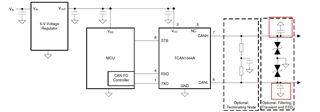Part Number: TCAN1044AV-Q1
Hi team,
My customer, DIN TCAN1044AV, wants to know the typical operating current of CANH and CANL pins when the IC is working, and the allowable current range of these two pins.
I didn't find relevant data in DATASHEET, may I ask if BU has relevant test data.
BR



